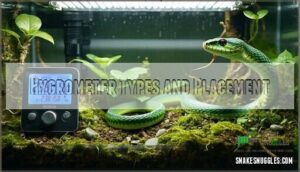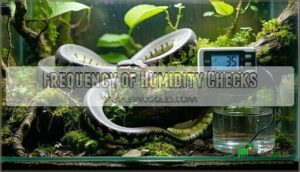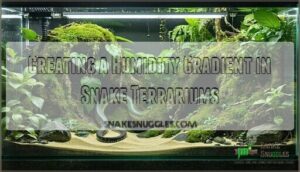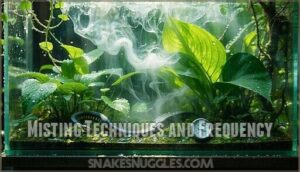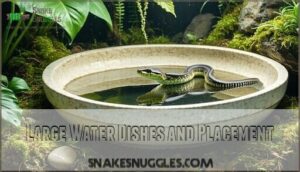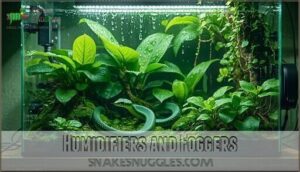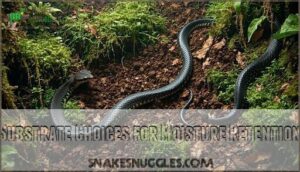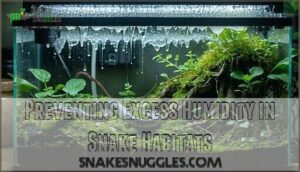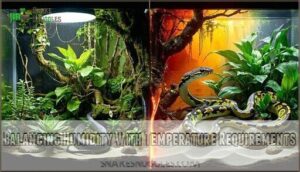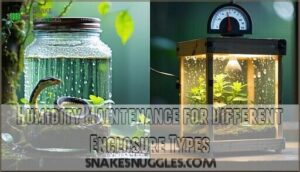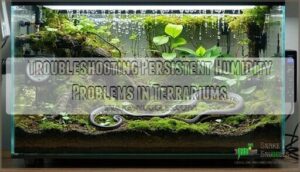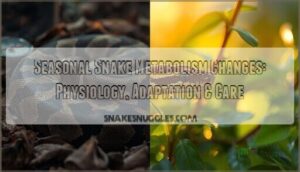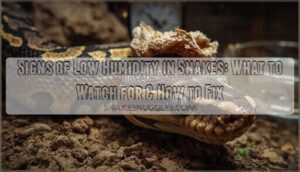This site is supported by our readers. We may earn a commission, at no cost to you, if you purchase through links.
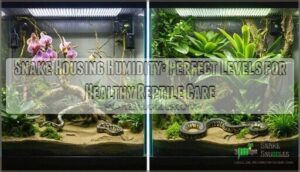 Your snake’s humidity needs depend on its species, but most thrive between 50-70%.
Your snake’s humidity needs depend on its species, but most thrive between 50-70%.
Desert dwellers like corn snakes prefer 40-60%, while tropical species like ball pythons need 60-80%.
Getting it wrong leads to stuck sheds, respiratory problems, or scale rot.
Use a digital hygrometer to monitor levels, create humidity gradients with moist and dry hides, and adjust through misting, water dish size, or substrate choices.
Think of it as creating your snake’s perfect weather forecast—too dry and they’ll struggle to shed, too wet and bacteria moves in like unwanted houseguests.
The secret lies in understanding your species’ wild home and the clever tricks that keep everything balanced.
Table Of Contents
- Key Takeaways
- Importance of Humidity in Snake Enclosures
- Optimal Humidity Levels for Different Snake Species
- Measuring and Monitoring Snake Tank Humidity
- Creating a Humidity Gradient in Snake Terrariums
- Effective Methods to Increase Enclosure Humidity
- Preventing Excess Humidity in Snake Habitats
- Balancing Humidity With Temperature Requirements
- Humidity Maintenance for Different Enclosure Types
- Troubleshooting Persistent Humidity Problems in Terrariums
- Frequently Asked Questions (FAQs)
- What humidity should my snake enclosure be?
- Is 70% humidity too high for a corn snake?
- Is 70% humidity too high for a ball python?
- How to make a snake enclosure less humid?
- How humid should my snakes tank be?
- Is 50% humidity okay for a ball python?
- Is too much humidity bad for a snake?
- How to reduce humidity in a snake enclosure?
- How often should I clean my snakes humid hide?
- Can misting affect a snakes feeding response?
- Conclusion
Key Takeaways
- Know your species’ humidity range – Ball pythons need 60-80%, corn snakes prefer 40-60%, and desert species require 20-40% humidity for optimal health
- Use digital hygrometers for accurate monitoring – Place them at snake level, away from heat sources and water bowls, to get reliable readings that prevent health issues
- Create humidity gradients with strategic placement – Set up dry hides on the cool side and moist hides on the warm side, so your snake can choose its preferred moisture level
- Balance humidity with proper ventilation – Too much moisture without airflow causes mold and respiratory infections, while good ventilation prevents stagnant air without losing necessary humidity
Importance of Humidity in Snake Enclosures
Creating the right humidity in your snake’s enclosure isn’t just about comfort—it’s literally a matter of life and death for your scaly friend.
Proper humidity isn’t optional—it’s what keeps your snake alive and thriving.
When humidity levels are off, you’ll see problems ranging from stuck sheds that can cut off circulation to respiratory infections** that can quickly become serious health issues.
Natural Habitat Replication
When setting up your snake’s home, think of yourself as creating a perfect copy of nature’s blueprint.
Your snake’s natural habitat holds the humidity secrets that keep them thriving in the wild.
- Biotope Enclosure Design – Match your snake’s original environment precisely
- Natural Behavior Encouragement – Proper reptile humidity lets snakes act naturally
- Environmental Enrichment – Habitat complexity supports physiological processes
- Species-Specific Setups – Each snake habitat needs customized moisture levels
Shedding Process Facilitation
Your snake’s shedding frequency depends on proper humidity levels.
Without adequate moisture, you’ll face stuck sheds that create serious health problems. Humidity’s role in maintaining skin elasticity guarantees healthy sheds every time.
| Humidity Level | Shedding Outcome |
|---|---|
| 40-50% | Patchy, difficult molts |
| 60-70% | Smooth, complete sheds |
| 80%+ (shedding period) | Perfect snake shedding |
| Below 30% | Severe shedding problems |
Think of humidity as your snake’s personal spa treatment. When moisture levels hit that sweet spot, smooth molts happen naturally. Your serpent will thank you for preventing those frustrating stuck shed situations!
Respiratory Health Maintenance
Your snake’s breathing easy when humidity levels stay just right—too dry and you’re looking at trouble.
Just the right humidity keeps your snake healthy—too little and they’re heading for trouble.
Respiratory infections love parched air, turning your pet’s lungs into a breeding ground for bacteria. Proper humidity acts like a natural shield, keeping airways moist and healthy.
Here’s what dry air does to your snake:
- Irritates delicate lung tissue, making it vulnerable to bacterial invasion
- Thickens mucus secretions, creating blockages that trap harmful pathogens
- Weakens natural defenses, allowing infections to take hold faster
Species susceptibility varies—some snakes handle drier conditions better than others. Ball pythons, for instance, need that tropical moisture to prevent respiratory distress. Ventilation importance can’t be overstated either; stagnant humid air breeds different problems.
Hydration and Overall Well-being
Think of humidity as your snake’s invisible bodyguard, working around the clock to keep everything running smoothly.
Proper snake humidity levels support turgor pressure in cells, assuring cellular function throughout your pet’s body.
Here’s how ideal humidity requirements boost snake wellbeing:
- Enhanced organ health through improved blood circulation
- Better digestive health for efficient nutrient absorption
- Assured snake hydration preventing dehydration stress
- Clear behavioral cues indicating your snake’s comfort level
Ideal humidity levels are crucial for maintaining your snake’s overall health, and by understanding the importance of humidity, you can provide a better environment for your pet.
Optimal Humidity Levels for Different Snake Species
Understanding your snake’s natural habitat is like knowing whether your friend prefers beach vacations or mountain retreats.
Tropical snake humidity runs 70-90% for species like Green Tree Pythons, while desert snake humidity stays much lower at 20-40% for Rosy Boas.
Temperate snake humidity falls somewhere between—Corn Snakes thrive at 50-70%.
Corn snakes also benefit from appropriate UVB lighting for their overall well-being.
During shedding, most snake species need a shedding humidity boost of 10-20% above normal levels to help the process along smoothly.
Measuring and Monitoring Snake Tank Humidity
You’ll need accurate humidity measurements to keep your snake healthy, and that means investing in the right monitoring tools.
Proper placement and regular checks guarantee you’re maintaining those perfect moisture levels your scaly friend needs to thrive, with accurate humidity measurements being crucial.
Hygrometer Types and Placement
Your hygrometer for snakes acts like a moisture meter, giving you the intel needed for proper reptile care.
Digital hygrometer models offer superior digital accuracy compared to analog hygrometer options requiring frequent analog calibration.
Smart placement strategy means positioning your hygrometer for reptiles at snake level, away from water bowls and heat sources.
Consider multiple hygrometers throughout the enclosure for thorough monitoring.
Proper hygrometer placement and reading interpretation guarantee your slithery friend stays comfortable and healthy.
It’s vital to understand species specific humidity for ideal reptile care.
Digital Vs. Analog Humidity Gauges
When choosing between digital and analog hygrometers, accuracy comparison reveals digital models outperform their analog counterparts substantially.
Digital hygrometers deliver precise readings within 2-3%, while analog versions often drift 10-20% from actual humidity levels.
Readability ease favors digital displays with clear LCD screens versus hard-to-interpret needle dials.
Cost analysis shows analog models start around $12.95, but digital hygrometers offer better value despite higher initial investment.
Durability factors lean toward digital units with fewer mechanical parts.
Both humidity measuring tools require calibration needs, though digital versions maintain stability longer for reliable humidity monitoring.
For superior reptile care, it’s vital to monitor terrarium humidity levels to guarantee the health and well-being of the animals.
Frequency of Humidity Checks
With your hygrometer properly positioned, keeping tabs on snake tank humidity becomes your routine.
Your monitoring schedule depends on your setup’s stability and your snake’s needs:
- Daily checks during shedding periods – your snake’s comfort depends on consistent moisture
- New setup monitoring – watch levels closely until patterns stabilize
- Seasonal changes – winter heating and summer cooling affect humidity levels
- Automation impact – even automated systems need regular verification
Experienced keepers with stable environments can check twice weekly, while beginners should monitor daily until they understand their enclosure’s behavior patterns.
Creating a Humidity Gradient in Snake Terrariums
Creating a humidity gradient in your snake’s enclosure isn’t just fancy terrarium design—it’s essential for your pet’s health and happiness.
You’ll need to set up different moisture zones so your snake can choose the perfect spot, just like they’d in the wild.
Dry and Moist Hide Boxes
Your snake needs options for humidity control in its enclosure.
Set up dry hide boxes with aspen shavings on the cool side, and moist hide boxes with damp sphagnum moss on the warm side.
This gives your snake the freedom to choose its preferred moisture level for ideal snake health and comfort.
Vertical Humidity Variation
Just as dry and moist hide boxes create horizontal humidity gradient options, vertical humidity stratification takes your snake enclosure to the next level.
Think of it as building a moisture skyscraper for your snake!
Place water dishes and humid hides at different heights throughout the enclosure.
Your snake will naturally explore these varying humidity levels, choosing what feels right for shedding or comfort.
Airflow dynamics create natural moisture layers, with higher humidity settling lower and drier air rising.
This setup mimics how species behavior works in nature – snakes climb trees or burrow underground to find their perfect moisture zone.
The gradient benefits are huge: your snake gets choices, and you get better humidity control.
Just remember, measurement challenges increase with multiple levels, so monitor each zone carefully.
Microclimate Zones
When you’re designing your snake enclosure, think of it as creating a humidity gradient with distinct microclimate zones that give your pet choices.
Here’s how to set up these humidity havens:
- Basking Spot – Keep it drier for temperature regulation
- Hiding Places – Offer both dry and humid options
- Substrate Moisture – Vary dampness across the enclosure
- Ventilation Control – Adjust airflow in different areas
- Water placement – Position strategically for localized humidity
This setup lets your snake move between humidity levels naturally, just like they’d find in the wild! Remember to use hygrometers to measure accurate humidity readings.
Effective Methods to Increase Enclosure Humidity
When your snake’s enclosure feels drier than a desert, it’s time to boost that humidity with some tried-and-true methods.
You’ll discover practical techniques that work whether you’re dealing with a stubborn ball python or a finicky corn snake that just won’t shed properly, using humidity to aid in the process.
Misting Techniques and Frequency
The right misting schedule transforms your snake’s home into a comfortable haven. Think of it as creating a gentle morning dew that mimics nature’s rhythm.
- Spray every 2-3 days for most species, increasing to daily during shedding periods
- Use dechlorinated water at room temperature to avoid shocking your snake’s system
- Target substrate edges rather than directly spraying your snake or automation options like timers
Quality spraying techniques with proper nozzle types guarantee effective humidity control without oversaturating the enclosure. Hygrometers aid in precise monitoring.
Large Water Dishes and Placement
Large water dishes are humidity powerhouses for your snake enclosure.
Position them near heat sources to maximize evaporation rate, boosting humidity levels naturally.
Choose ceramic or glass dishes for easy cleaning frequency – weekly works great.
Dish size matters: bigger means more surface area for humidity control.
Your snake might even enjoy a soak while you’re managing water dishes in the enclosure!
Humidifiers and Foggers
Beyond water dishes, humidifiers and foggers offer automated humidity control for your snake’s enclosure.
These devices maintain consistent moisture levels without constant manual intervention, making them perfect for busy reptile keepers.
A reliable way to maintain humidity is to purchase a humidifier.
- Ultrasonic humidifiers – produce cool mist safely for temperature-sensitive species
- Reptile foggers – create natural fog effects while boosting humidity gradually
- Programmable timers – automate humidity cycles to prevent over-humidification
- Safety shut-offs – protect equipment when water levels drop too low
Substrate Choices for Moisture Retention
Coconut coir and cypress mulch are your humidity heroes – they hold moisture like champs!
Sphagnum moss absorbs 20 times its weight in water, while peat moss creates perfect soil blends.
Smart substrate choices mean better substrate moisture control.
You can find various coir based products for reptile enclosures.
Mix these substrate options for ideal humidity without constant misting.
Your snake’s substrate safety depends on proper substrate management.
Preventing Excess Humidity in Snake Habitats
While high humidity benefits many snakes, too much moisture can spell trouble for your scaly friend’s health.
You’ll need to master proper ventilation and substrate management to prevent mold growth, respiratory infections, and other humidity-related problems.
These humidity-related problems can turn your snake’s cozy home into a health hazard.
Proper Ventilation Techniques
While creating the perfect humid environment for your snake is important, you can’t forget about snake enclosure ventilation. Too much humidity without proper airflow balance turns your snake housing into a breeding ground for nasty mold and bacteria.
Vent placement makes all the difference in your snake enclosure. Side vents help retain humidity, while top vents release it—choose based on your species needs. Your enclosure material also matters: glass terrariums need more active ventilation than plastic tubs.
Here’s what proper snake enclosure ventilation looks like:
- Cool air flowing in low, warm air flowing out high
- Gentle breeze that doesn’t create drafts on your snake
- Fresh air circulation that prevents stagnant pockets
Mold prevention starts with smart ventilation choices. You’re not creating a wind tunnel—just enough airflow to keep things fresh while maintaining those perfect humidity levels your snake craves.
Substrate Management and Replacement
In the context of substrate management and replacement, you’re dealing with one of the most critical aspects of humidity control. Your snake substrate choice directly impacts moisture levels, making substrate selection a game-changer for maintaining ideal conditions.
Substrate Types vary dramatically in their moisture-retention properties. Coconut husk and cypress mulch excel at holding humidity, while aspen shavings offer moderate retention. Paper towels provide minimal moisture but simplify cleaning frequency monitoring.
| Substrate Type | Moisture Retention | Replacement Schedule |
|---|---|---|
| Coconut Husk | High | 4-6 weeks |
| Cypress Mulch | Medium-High | 3-4 weeks |
| Aspen Shavings | Medium | 2-3 weeks |
| Paper Towels | Low | 1-2 weeks |
Regular replacement prevents mold prevention issues and reduces impaction risks from degraded materials. Bioactive benefits include natural humidity regulation through beneficial microorganisms. Monitor your reptile substrate weekly for odors or visible contamination—these signal immediate replacement needs.
Balancing Humidity With Temperature Requirements
Managing humidity and temperature together takes some finesse, but it’s totally doable once you understand how they work as a team.
Your heating elements will naturally lower humidity levels, while your moisture-boosting methods can affect those carefully crafted temperature gradients you’ve worked so hard to create.
Heat Sources and Their Impact
Your snake’s heat source directly impacts humidity levels in ways you mightn’t expect. Overhead heat bulbs can dry out your enclosure quickly, while heat mats boost substrate moisture through evaporation.
- Heat Source Types affect air circulation and moisture retention differently
- Temperature Gradients create natural humidity variations across your enclosure
- Basking Spot Humidity drops substantially under direct heat lamps
- Infrared Emitters provide gentler heating with less moisture loss
- Heat Rock Dangers include uneven heating and potential humidity dead zones
Day-Night Humidity Fluctuations
Just like your home feels different at night, your snake’s enclosure experiences natural cycles too. As temperatures drop after lights-out, humidity levels typically rise – it’s Mother Nature’s way of keeping things balanced.
Most species adapt to these day-night fluctuations naturally, but monitoring methods help you track patterns. Watch for health implications if swings are too dramatic. Some snakes handle 10-15% humidity changes well, while others need steadier conditions.
Here’s what to expect throughout the day:
| Time Period | Humidity Pattern | Snake Behavior | Management Tips |
|---|---|---|---|
| Morning (6-10 AM) | Moderate levels | Active feeding time | Check hygrometer readings |
| Midday (10 AM-4 PM) | Lowest humidity | Basking, hiding | Mist if needed |
| Evening (4-8 PM) | Gradual increase | Moderate activity | Monitor humidity gradient |
| Night (8 PM-2 AM) | Highest levels | Peak activity | Guarantee proper ventilation |
| Late Night (2-6 AM) | Stable high | Rest period | Automation options helpful |
Your humidity requirements don’t need constant tweaking – gentle fluctuations actually mimic what snakes experience in the wild, promoting natural behaviors.
Seasonal Humidity Adjustments
Just like gardeners adjust their watering schedules, you’ll need to modify humidity levels with the seasons.
Winter heating systems dry out your home, requiring Winter Humidity boosts to prevent dehydration.
Summer Adjustments typically mean reducing moisture since warmer air holds more water naturally.
Watch your snake’s Species Sensitivity during Molting Season – they need extra humidity regardless of weather.
Regional Variations matter too, since Arizona summers differ from Florida’s!
Humidity Maintenance for Different Enclosure Types
The type of enclosure you choose dramatically affects how easy it’ll be to maintain proper humidity levels for your snake.
Glass terrariums, plastic tubs, and wooden vivariums each have unique challenges and advantages regarding moisture control.
Glass Terrariums Vs. Plastic Tubs
Several factors differentiate glass terrariums from plastic tubs when managing snake humidity. Glass terrariums offer excellent material transparency for monitoring your snake, but they’re heavier and more expensive than plastic alternatives. Heat retention varies between materials – glass holds temperature steadily while plastic provides better insulation. Plastic tubs excel in cleaning ease and cost analysis, making them budget-friendly humidity champions.
Here’s what you’ll experience with each option:
- Feel confident knowing plastic tubs naturally maintain higher humidity levels
- Enjoy peace of mind with glass tanks’ superior visibility for health monitoring
- Appreciate the savings when choosing affordable plastic over pricier glass options
- Experience satisfaction from easier cleaning routines with smooth plastic surfaces
Your snake enclosure choice impacts reptile enclosure humidity management substantially. Plastic tubs require less misting frequency, while glass terrariums need more active humidity control through water dishes and substrate moisture.
Wooden Vivariums and Humidity Control
You’ll want to seal wooden vivariums properly since they’re humidity magnets. Apply marine-grade polyurethane or epoxy resin to prevent rot and humidity damage.
Strategic ventilation challenges require cross-flow air movement with adjustable vents. Choose hardwoods over softwoods for better moisture resistance.
Monitor snake humidity levels carefully with digital hygrometers, as wood choice affects your enclosure’s ability to maintain stable conditions.
Bioactive Setups and Natural Humidity
Bioactive setups transform your snake’s home into a living ecosystem where natural humidity works like magic.
Decomposers and microorganisms in the soil ecosystem break down waste while maintaining perfect moisture levels.
Plant integration creates natural cycling – plants absorb excess humidity during the day and release it at night.
This self-regulation means less work for you and healthier substrate choices for consistent humidity maintenance.
Troubleshooting Persistent Humidity Problems in Terrariums
Even experienced snake keepers can find themselves battling stubborn humidity issues that seem impossible to fix.
Don’t worry—persistent humidity problems usually have clear solutions once you know where to look and what adjustments to make.
Identifying Sources of Excess Moisture
Excess humidity can turn your snake’s home into a breeding ground for problems. Over-Misting creates soggy conditions that encourage mold growth and respiratory issues. Water Spillage from oversized bowls or careless handling saturates substrate and raises humidity dangerously high.
Here’s your moisture detective checklist:
- Poor Ventilation – blocked air vents trap humid air inside
- Humid Hides – overly wet moss or substrate creates moisture bombs
- Substrate Saturation – waterlogged bedding becomes a humidity factory
- Overhumidification – excessive misting schedules flood the enclosure
Regular monitoring prevents these sneaky culprits from turning your terrarium into a swamp!
Addressing Low Humidity Issues
When you’re dealing with low humidity, start by increasing your misting frequency – aim for daily spritzes with dechlorinated water.
Swap out that tiny water dish for a larger one, which boosts evaporation naturally. Substrate options like coconut coir or cypress mulch hold moisture better than paper towels.
Check your ventilation balance – too much airflow dries things out fast. For stubborn cases, incomplete sheds can be a sign of low humidity.
For stubborn cases, humidifier types designed for reptiles work wonders, providing consistent moisture without the guesswork.
Fine-tuning Humidity Levels Over Time
Perfect humidity control takes practice, like learning your snake’s unique personality.
Start with small adjustments, then observe how your reptile responds during shedding cycles and growth stages.
Keep detailed records tracking seasonal adjustments and environmental changes.
Long-term monitoring reveals patterns that help you master finetuning your humidity gradient using reliable humidity control tools.
Frequently Asked Questions (FAQs)
What humidity should my snake enclosure be?
Your snake’s humidity needs depend on its species. Ball pythons require 60-80%, corn snakes need 40-60%, and desert species prefer 20-40%. Use a digital hygrometer to monitor levels accurately.
Is 70% humidity too high for a corn snake?
Yes, 70% humidity is too high for corn snakes. They thrive at 40-60% humidity, so you’ll want to dial it back to prevent respiratory issues and scale rot from developing.
Is 70% humidity too high for a ball python?
Like a gentle rain nurturing a tropical garden, 70% humidity isn’t too high for your ball python—it’s actually perfect.
Ball pythons thrive in 60-80% humidity, so you’re right in their sweet spot for healthy shedding.
How to make a snake enclosure less humid?
To reduce humidity in your snake enclosure, increase ventilation by adding more air vents.
Use smaller water bowls, switch to drier substrates like newspaper, and reduce misting frequency until you reach ideal levels.
How humid should my snakes tank be?
Your tank’s humidity depends on your snake’s species. Ball pythons need 60-80%, corn snakes prefer 40-60%, and tropical species require 70-90%. Use a hygrometer to monitor levels accurately.
Is 50% humidity okay for a ball python?
You’re walking a tightrope here – 50% humidity is too low for your ball python. These tropical snakes need 60-80% humidity to thrive, shed properly, and avoid respiratory issues.
Is too much humidity bad for a snake?
Yes, too much humidity can harm your snake.
Excessive moisture creates perfect conditions for bacterial infections, respiratory problems, and scale rot.
It’s like turning your snake’s home into a swamp – definitely not healthy!
How to reduce humidity in a snake enclosure?
Like a sponge wrung out, your enclosure needs less moisture retention. Increase ventilation, use smaller water bowls, switch to drier substrates, and reduce misting frequency to lower humidity effectively.
How often should I clean my snakes humid hide?
Clean your snake’s humid hide weekly or whenever you notice mold, smell, or soiled substrate.
During shedding periods, check it daily and clean immediately after use to prevent bacterial growth and maintain proper hygiene.
Can misting affect a snakes feeding response?
Misting can temporarily dampen your snake’s feeding response since it changes the enclosure’s scent profile and humidity levels.
Potentially making your snake less active or alert to prey cues until conditions stabilize, is a result of the changed environment, however, temporarily is the key factor in this situation.
Conclusion
Perfect snake housing humidity isn’t just about numbers—it’s about creating a living ecosystem that mirrors your serpent’s wild home.
You’ve learned the species-specific ranges, monitoring techniques, and adjustment methods that prevent health disasters.
Whether you’re battling stuck sheds or preventing scale rot, remember that consistency trumps perfection. Your snake doesn’t need laboratory-precise conditions, just stable, appropriate levels that let them thrive.
Master these fundamentals, and you’ll watch your scaled friend flourish in their carefully crafted habitat with stable conditions.
- https://familysnake.com/guides/keeping-your-snake-happy-how-to-monitor-humidity-levels/
- https://talis-us.com/blogs/news/maintaining-optimal-humidity-for-corn-snakes
- https://reptifiles.com/ball-python-care-guide/ball-python-humidity-temperatures/
- https://bushveldreptiles.com/house-snake-care-guide
- https://www.wilbanksreptiles.com/blogs/ball-pythons/common-ball-python-health-issues-and-how-to-prevent-them


